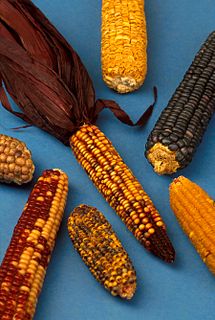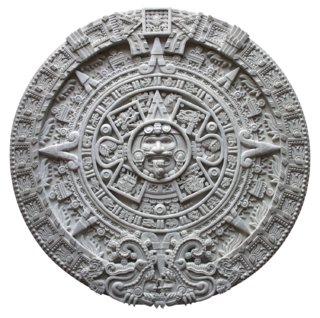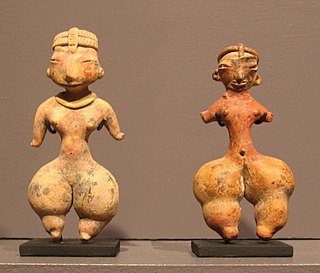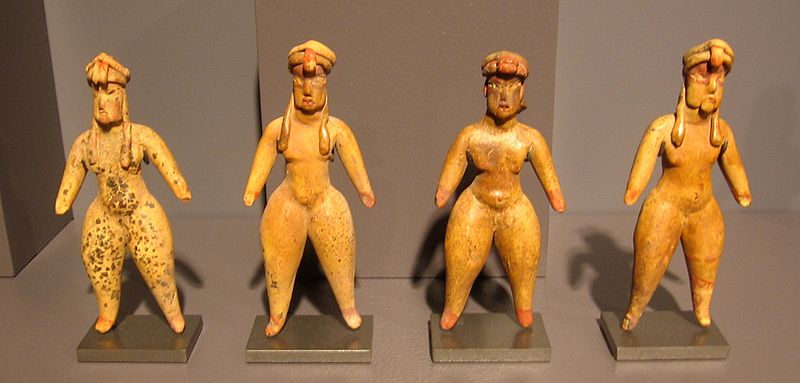
The Olmecs were the earliest known major civilization in Mesoamerica following a progressive development in Soconusco. They lived in the tropical lowlands of south-central Mexico, in the present-day states of Veracruz and Tabasco. It has been speculated that the Olmecs derive in part from neighboring Mokaya or Mixe–Zoque.

La Venta is a pre-Columbian archaeological site of the Olmec civilization located in the present-day Mexican state of Tabasco. Some of the artifacts have been moved to the museum "Parque - Museo de La Venta", which is in nearby Villahermosa, the capital of Tabasco.

Agriculture in Mesoamerica dates to the Archaic period of Mesoamerican chronology. At the beginning of the Archaic period, the Early Hunters of the late Pleistocene era led nomadic lifestyles, relying on hunting and gathering for sustenance. However, the nomadic lifestyle that dominated the late Pleistocene and the early Archaic slowly transitioned into a more sedentary lifestyle as the hunter gatherer micro-bands in the region began to cultivate wild plants. The cultivation of these plants provided security to the Mesoamericans, allowing them to increase surplus of "starvation foods" near seasonal camps; this surplus could be utilized when hunting was bad, during times of drought, and when resources were low. The cultivation of plants could have been started purposefully, or by accident. The former could have been done by bringing a wild plant closer to a camp site, or to a frequented area, so it was easier access and collect. The latter could have happened as certain plant seeds were eaten and not fully digested, causing these plants to grow wherever human habitation would take them.

Mesoamerican chronology divides the history of prehispanic Mesoamerica into several periods: the Paleo-Indian, the Archaic, the Preclassic or Formative, the Classic (250–900CE), and the Postclassic, Colonial (1521–1821), and Postcolonial (1821–present). The periodization of Mesoamerica is based on archaeological, ethnohistorical, and modern cultural anthropology research. The endeavor to create cultural histories of Mesoamerica dates to the early twentieth century, with ongoing work by archeologists, ethnohistorians, historians, and cultural anthropologists.
Domesticated plants of Mesoamerica, established by agricultural developments and practices over several thousand years of pre-Columbian history, include maize and capsicum. A list of Mesoamerican cultivars and staples:

Tlapacoya is an important archaeological site in Mexico, located at the foot of the Tlapacoya volcano, southeast of Mexico City, on the former shore of Lake Chalco. Tlapacoya was a major site for the Tlatilco culture.

Aridoamerica denotes an ecological region spanning Mexico and the Southwest United States, defined by the presence of the culturally significant staple foodstuff Phaseolus acutifolius, a drought-resistant bean. Its dry, arid climate and geography stand in contrast to the verdant Mesoamerica of present-day central Mexico into Central America to the south and east, and the higher, milder "island" of Oasisamerica to the north. Aridoamerica overlaps with both.

Mesoamerica is a historical region and cultural area in North America. It extends from approximately central Mexico through Belize, Guatemala, El Salvador, Honduras, Nicaragua, and northern Costa Rica, and within this region pre-Columbian societies flourished before the Spanish colonization of the Americas in 16th century European diseases, like small pox and measles, caused the deaths of upwards of 90% of the indigenous people. It is one of five areas in the world where ancient civilization arose independently, and the second in the Americas along with Norte Chico (Caral-Supe) in present-day Peru, in the northern coastal region.

Ancient Maya cuisine was varied and extensive. Many different types of resources were consumed, including maritime, flora, and faunal material, and food was obtained or produced through a host of strategies, such as hunting, foraging, and large-scale agricultural production. Plant domestication focused on several core foods, the most important of which was maize.
Christine Niederberger Betton, born in Bordeaux and died in 2001 in Mexico City, was a French archaeologist. She is mainly noted for her contributions to the field of pre-Columbian American archaeology, in particular for her work on Mesoamerican cultures in central Mexico.
The causes and degree of Olmec influences on Mesoamerican cultures has been a subject of debate over many decades. Although the Olmecs are considered to be perhaps the earliest Mesoamerican civilization, there are questions concerning how and how much the Olmecs influenced cultures outside the Olmec heartland. This debate is succinctly, if simplistically, framed by the title of a 2005 New York Times article: “Mother Culture, or Only a Sister?”.

Classic Veracruz culture refers to a cultural area in the north and central areas of the present-day Mexican state of Veracruz, a culture that existed from roughly 100 to 1000 CE, or during the Classic era.

San Andrés is an Olmec archaeological site in the present-day Mexican state of Tabasco. Located 5 km northeast of the Olmec ceremonial center of La Venta in the Grijalva river delta section of the Tabasco Coastal Plain, San Andrés is considered one of its elite satellite communities, with evidence of elite residences and other elite activities. Several important archaeological finds have been made at San Andrés, including the oldest evidence of the domesticated sunflower, insight into Olmec feasting rituals, didactic miniatures, and possible evidence of an Olmec writing system.

Guitarrero Cave is located in the Callejón de Huaylas valley in Yungay Province, in the Ancash region of Peru. The cave stands 50 m (160 ft) above Rio Santa and 2,580 m (8,460 ft) meters above sea level.
Mokaya were pre-Olmec cultures of the Soconusco region in Mexico and parts of the Pacific coast of western Guatemala, an archaeological culture that developed a number of Mesoamerica’s earliest-known sedentary settlements.
Coxcatlan Cave is a Mesoamerican archaeological site in the Tehuacán Valley of Puebla, Mexico. It was discovered by Richard MacNeish in the 1960s during a survey of the Tehuacán Valley. It was the initial appearance of three domesticated plants in the Tehuacan Valley and allowed an evaluation to be done again of the overall temporal context of the plant domestication in Mexico. In addition to plants, Coxcatlan Cave also provided nearly 75 percent of the classified stone tools from excavation.

Guilá Naquitz Cave in Oaxaca, Mexico is the site of early domestication of several food crops, including teosinte, squash from the genus Cucurbita, bottle gourds, and beans. This site is the location of the earliest known evidence for domestication of any crop on the continent, Cucurbita pepo, as well as the earliest known domestication of maize.
The Archaic period, also known as the preceramic period, is a period in Mesoamerican chronology that begins around 8000 BCE and ends around 2000 BCE and is generally divided into Early, Middle, and Late Archaic periods. The period is preceded by the Paleoindian period and followed by the Preclassic period. Scholars have found it difficult to determine exactly when the Paleoindian period ends and the Archaic begins, but it is generally linked with changing climate associated with the transition from the Pleistocene to the Holocene epochs, and absence of extinct Pleistocene animals. It is also generally unclear when the Archaic period ends and the Preclassic period begins, though the appearance of pottery, large-scale agriculture, and villages signal the transition.














